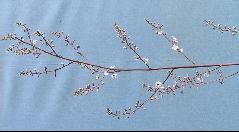
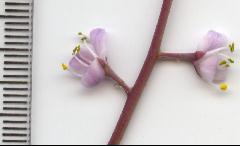
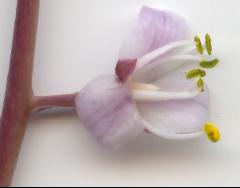
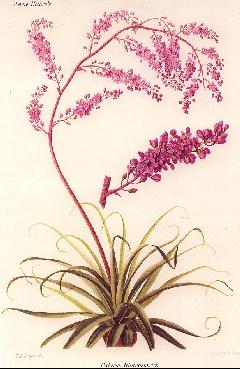
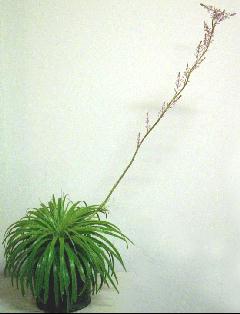
Let us first look at what has been written about this plant. First there is the magnificent painting done for Andre in 1889 as a Bakeria of what appears to be a male plant with a bipinnate inflorescence and shows a bit of artistic licence in the size of the flowers and total colour of the petals. In reality the male petals are white with splashes of dark pink especially towards the tips even though Lyman Smith describes them as just white (for female flowers?). Smith also tells us that the plant flowers less than 1m high with an amply tripinnate inflorescence and is very graceful and delicate.
What does astound me is how taxonomists link the two sexes of a species because as John Utley points out, many seem to have differences in plant habit depending on sex! One can only assume that each of the sexes must be growing in the immediate vicinity so that pollinators can at least find it easy to transfer pollen. AND in these days of man’s intervention in the insect and other wild life populations, it makes you wonder about their survival.
Hechtia tillandsioides was described from a painting and no information was given as to where the plant may have been collected. It is therefore an enigma as to how the taxonomists link it to live (herbarium!) material. There does appear to be other similar finely toothed hechtias found in Mexico. For example we know that in 2004 in the Bromeliaceae of Mexico checklist Adolfo Espejo Serna proposed the resurrection of a Hechtia purpusii and linking it with H. lindmanioides. Smith had treated H. purpusii as a synonym of H. tillandsioides. While we do not know where H. tillandsioides was originally from, we do know that H. lindmanioides comes from Barranca de Consoquitla, Vera Cruz and H. purpusii comes from Barranca de Tenampa, Vera Cruz. Whether this proposal will be accepted by his peers we can only wait and see.
If we look at Smith’s key to Hechtia we see H lindmanioides at #20. and H. tillandsioides at #21. The main difference being in the size of the flower, said to be 3mm in H. lindmanioides and 5mm in H. tillandsioides whereas our plant is about 7mm. Now, Lyman Smith had treated H. purpusii as a synonym of H. tillandsioides and if you read the original description by Brandegee in 1920 it seems to be the right decision. If you treat H. purpusii as synonymous with H. lindmanioides then the combination of the diagnostic information makes this H. purpusii even closer to H. tillandsioides. I have had to scan my flowers at 1200dots per square inch so I can see what these measurements look like! Nothing is written about H. tillandsioides male plants and yet, as John Utley has pointed out, there can be substantial differences between male and female plants!
Why am I telling you this? Well, there is this possibility that our H. tillandsioides is wrongly identified and one easy way to find out identity is to ascertain where the plant was collected.
This leads me on the track of how our H. tillandsioides got to Australia and where it was collected. Only male plants seem to be in Australia although why it was left to South Aussies to pick this up I don’t know! How do we know it is male? Well, it has 6 prominent stamens and oodles of pollen when the flower first opens. When you try to find the stigma lobes in the centre of the flower all you find is a little stub which is no use to man or beast! No wonder it is a frustrated plant and we must find it a mate! Did this plant in Australia start from seed because if so, then there must be a female plant around. Regrettably, I think they are all offsets from the same plant and all roads – so far - lead to John Catlan of Jacob’s Well, Qld. John tells me he got his from Mary Nicholson who almost certainly got hers from Olwen Ferris. It did not appear in any of Olwen’s catalogues that I can trace so it must have been rare in her collection. It is slow to offset and seems to need to form a clump to flower. What we do not know is how often it flowers once a clump has formed and John Catlan has promised to let me know. Because it takes 4-5 years to clump there is much waiting for the plant to flower.
The key points to watch are:
1. Is anyone growing a female plant for my frustrated one?
2. Does anyone know where Olwen may have got her plant? I think it must have been when she was in Queensland because there are no NSW leads.
3. There may be a name change in the offing!
If you look at http://fcbs.org under Hechtia tillandsioides you will see a white petalled plant that is tripinnate and agrees more closely to Smith’s description of the female plant. I wonder if Ken Marks checked for sex!
Derek Butcher.




